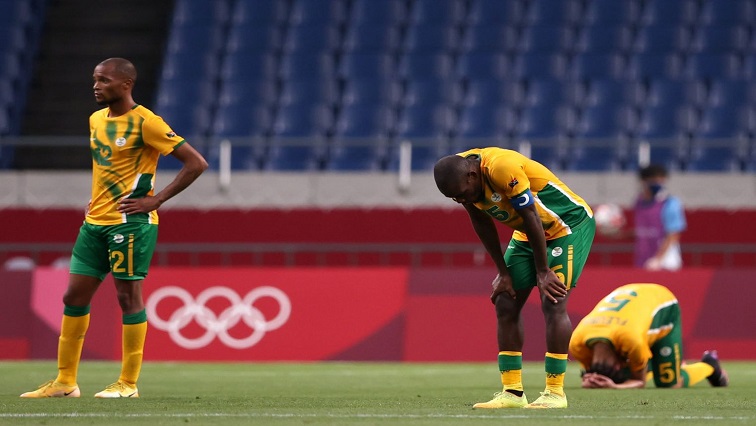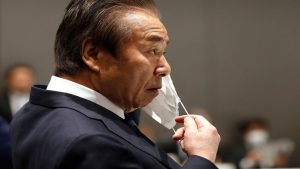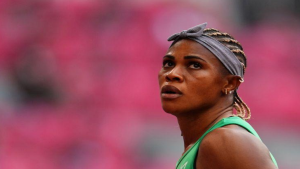Once again, a South African national team made it onto the world stage and failed to live up to the expectations. As usual, going to the final match, after two losses, calculators were out trying to make sense of backdoor chances of going through and as usual, the team failed yet again.
These events undoubtedly give rise to the temptation to jump onto the regular bandwagon of rubbishing the national team and local football. But a couple of pertinent questions arise; first and foremost being “and then what?”
“Are Notoane’s line-ups, tactics and substitution, the conversation we should be having?”
“Was it really doom and gloom in Tokyo?”
But most importantly, “what conversation should we be having?”
So, let’s start with the first question – “and the what?”
It’s pointless and completely misguided to go off on a tangent rubbishing the team that went to Tokyo labelling them mediocre and all sorts of negative adjectives. Attacking those boys completely misses the real point and that is they can only be as good as the system that produced them. But in this case, that is not even the case. Taking a closer look at the reality of football development that is fraught with inadequacies on many levels in this country, one would realise that these players are actually making a success of their careers despite the system, instead of because of it. They are being criticised for flopping yet again. But this is a different generation. These are NOT the players that failed at the World Cup in 2002; failed to qualify for the 2006 World Cup; failed to score a goal at the 2006 Africa Cup of Nations; became the first host nation squad to fail to progress to the knockout stages in 2010 and so on. Generations of players come and go but the rubbishing of players remains. We should be careful not to be caught in the routine, because all these speak to the system that is producing these players – generation after the other. It’s utterly naïve to overlook the system and accuse players of lacking the hunger, motivation, killer instinct and will to win. One on one with them they will tell they want to play at the highest level and want to compete even for the Ballon d’or. But why are they not? The system!
Now, the second question – “Are Notoane’s line-ups, tactics and substitution, the conversation we should be having?”
A complete waste of time! We did that with Clive Barker, Jomo Sono, Shakes Mashaba and all the coaches that happened to lead our national teams on the big stages and it has gotten us nowhere. A complete misdiagnosis and distraction from real issues. Don’t we learn? It’s a futile conversation that deserves no further space in this piece.
“Was it really doom and gloom in Tokyo?”
Not completely. It is important to note there were three varied emotional reactions to the three games that the SAU23 played. There was a mixture of anger and frustration following the team’s 1-0 loss to Japan in the opening match, in which the team mostly sat back and looked much without purpose. There was, however, a new sense of hope and positivity despite the obvious disappointment following 4-3 loss to France in the second match, in which team took the game to France and, albeit in glimpses, showed purpose going forward with short pass interplay, which are a very strong attribute of the South Africa style of play. And then there was anger and despair after the third and final match against Mexico, which the team lost 2-0, and totally never pitched.
Now, it is interesting that all those different emotional reactions fluctuated with the fluctuation of formations employed by the technical team. 1-3-4-3 in the opening match, then 1-4-3-3 in the second match and 1-4-2-3-1 in the final match.
This tells a story, if we move away from the as-long-as-we-win mentality in which shortcomings can’t be seen as long as you win, no matter how accidental, and positives cannot be noted as long as you lose. It does not take rocket science to note that while the Tokyo expedition bombed out, these formation fluctuations have given us something to think about. This, more especially with the purpose in play in the second game with the 1-4-3-3 formation which seemed to allow, albeit sporadically, the manifestation of a style of play, that not only gave the French defence problems, but also imposed the talent in our team in which the names, Thabo Cele, Nkosingiphile Ngcobo, Kobamelo Kodisang, Tebogo Mokoena, and Evidence Makgopa got to shine despite the loss. Other than Ngcobo, all these players were mostly there in all three games, but it was in the second match that they got to shine. The answer is in the game system. This should make sense if one is aware of the strong relationship that exists between a formation, and football concepts, both of which will result in how far players get to impose themselves. Gambling with formations, unfortunately, speaks to the uncertainty of a playing concept or football philosophy even by the technical team that went to Toyko themselves.
Which bring us to the next question – “what conversation should we be having?”
Until we have right conversations, make correct diagnosis and collectively work together to improve the standard of the game in this country, we will never see any progress.
Firstly, David Notoane and company should not be unsure of a playing concept. Leading up to Tokyo they seemed to be leaning towards a playing concept that seemed to relatively maximise the potential of the local talent and duly raised hopes before heading east. Judging by the performance in the second match against France, it does seem they had made some progress in entrenching a particular playing concept. A junior national team prepares players for the senior national team and the question is if Notoane and company win in preparing these players within a South African playing concept, who are they preparing those players for? And that is the question of uniformity in style of play that is seldom asked. For Hugo Broos? Who’s he in terms of understanding the specific traits of South African talent, football culture and its strengths and weaknesses? Thought as much!
Now, until there is that uniformity in thinking about a playing philosophy throughout the national team structures, what is prepared at U17 will likely fall off at U20 and what is prepared at U20 will likely fall off at U23 and the results of that is what you have with Bafana Bafana currently. Shambles!
But talking about preparing players, uniformity at national team level, at whichever age group, is already thinking ahead of ourselves. Who is preparing players for national teams? Those are the most important role players, and often overlooked, in this chain of realising your potential on the world stage. And those are the coaches at club level who spend time with the players week in and week out, which brings us to the urgency of national football indaba. Without the buy-in of the club owners and coaches, national teams are doomed and South Africa cannot afford to continue to overlook the importance of coaches in the PSL and the lower leagues.
There has already been a Technical Symposium in 2012. However, while the idea was brilliant, how SAFA went about it left much to be desired. The discussion was left to German Football Federation technicians including Joerg Daniel and Thorsten Becht of the DFB, without much contribution from PSL coaches on how they think is the best way of play football locally and how they can contribute to that playing philosophy. The truth is our people – and our people only – understand more than anybody else the nature of the problems the local football is facing. All these people who fail to fill the stadiums today, used to fill stadiums to capacity during those days of segregation to watch the likes of Jomo ‘The Black Prince’ Sono, Kaizer ‘Chincha Guluva’ Motaung, Patrick ‘Ace’ Ntsoelengoe, Teenage Dladla, etc. They don’t need a German, Dutch or any outsider to tell them what is good for their football. They know their football …they call it idiski. Germans don’t know these things! Our people also know their own challenges. They don’t need to invite foreigners to discuss their problems and offer them possible solutions. Let our most qualified people be given a chance to state their cases and deliver themselves out of this mess.
In 2019, Minister of Sports Nathi Mthethwa raised the need for a national indaba. However, the suggestion was not well received by SAFA and the idea never got to materialise.
But the recent SAU23 Tokyo fiasco highlights the urgent need for this football indaba – now more than ever.
Point No.: 1 on SAFA’s Vision 2022 is Football Philosophy but there is no plan on how to get professional club owners to support that philosophy in the calibre of coaches they bring to the country. Successful nations like Spain, Germany, Belgium to name but a few, never achieved their identity without the conversation on the style of play without professional club owners and coaches. Even in Tokyo, looking at the Spanish U23 side play, you see Barcelona, you see La Liga and you see the Spanish national team. It was the same with the German U23 who’s style of play reflects Bayern Munich, Bundesliga and the senior national team.
The question is does the SAU23’s style reflect Kaizer Chiefs, Orlando Pirates, Mamelodi Sundowns, the PSL, GladAfrica Championships or the senior national team and so on? Don’t bother answering the question because the answer is a big “No”, and we must never raise our hopes until we can answer “Yes” to that question and that is why it is urgent that we have this football indaba as a matter of urgency with all the professional club owners and their technical staff.
In most successful nations every season there are at least two workshops with all professional coaches to recommend and target minimal technical standards for professional football.
Once that is done, it is important that look at the quality of those bestowed mapping the technical direction our football needs to take – from the technical director to the composition of the technical committee.
In pursuit of any semblance of success in any high-performance environment; success on field of play must be matched by quality, expertise off the field in shape of technical staff, medical staff and all other support staff.
We can’t be giving support and technical staff opportunities merely to gain experience at these global competition levels as it was the case with the Tokyo Olympics. Such experiences must be gained, sharpened over a period of years with highest forms of domestic competitions and even locals who work successfully outside borders of the country. Careful selection of technical and other support staff must be made strictly on high merits and in line with overall performance objectives, sharing similar mentality in relation to a national playing philosophy!
A cohesive detailed national technical policy, designed by a diverse group of experts should include criteria on appointing, not only, technical staff to national teams at all levels, but also strict guidelines on appointment of all other support and medical staff.
This technical policy should also provide guidelines and a framework on how and why coaches select players for the various national teams – all in line with long-term vision and performance objectives of the South African Football Association and the country.
All these can be done and South Africa would realise its full potential.
But lastly, the next conversation we need to have is the nature of the “abnormal” relationship between SAFA and the PSL and its impact on the quality of the game in the country.
By Sipho ‘King K’ Kekana @KingKAzania





